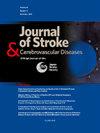Association between plain water intake and stroke among American adults: National health and nutrition examination survey 1999-2020
IF 1.8
4区 医学
Q3 NEUROSCIENCES
Journal of Stroke & Cerebrovascular Diseases
Pub Date : 2025-06-07
DOI:10.1016/j.jstrokecerebrovasdis.2025.108372
引用次数: 0
Abstract
Background
Stroke is a leading cause of disability and mortality. While plain water intake has been linked to stroke-related risk factors—including hypertension, diabetes, and obesity—its direct relationship with stroke remains unclear. This study aimed to evaluate the association between plain water intake and stroke.
Methods
We analyzed data from adults aged over 20 years who participated in the National Health and Nutrition Examination Survey between 1999 and 2020. Information on stroke status, plain water intake, and other relevant variables was collected. We used weighted logistic regression models, restricted cubic spline analysis, stratified analysis with interaction testing, threshold effect analysis, and sensitivity analyses to evaluate the association.
Results
A total of 29,489 participants were included, of whom 1,268 (3.18 %) reported having been diagnosed with stroke. Significant differences in stroke prevalence and participant characteristics were observed across quartiles of water intake (P < 0.001). Multivariable regression indicated a negative association between plain water intake and stroke risk in all adjusted models. The relationship followed an l-shaped curve, with an inflection point at approximately 1,382.86 mL/day (non-linearity, P = 0.005). For those consuming ≤1,382.86 mL/day, the odds ratio for stroke was 0.97 (95 % CI: 0.93 – 0.99, P = 0.03). Subgroup, interaction, and sensitivity analyses supported the stability of the results.
Conclusion
The association between plain water intake and stroke among U.S. adults follows an L-shaped curve, with an inflection point near 1,382.86 mL/day. Further research is warranted to investigate the mechanisms underlying this association.
美国成年人白开水摄入量与中风之间的关系:1999-2020年全国健康与营养调查
背景:中风是致残和死亡的主要原因。虽然白开水的摄入与中风相关的风险因素有关,包括高血压、糖尿病和肥胖,但它与中风的直接关系尚不清楚。本研究旨在评估白开水摄入与中风之间的关系。方法:我们分析了1999年至2020年参加国家健康与营养检查调查的20岁以上成年人的数据。收集了中风状态、白开水摄入量和其他相关变量的信息。我们使用加权逻辑回归模型、受限三次样条分析、分层交互检验分析、阈值效应分析和敏感性分析来评估相关性。结果:共纳入29,489名参与者,其中1,268人(3.18%)报告被诊断为中风。在不同饮水量的四分位数中观察到卒中患病率和参与者特征的显著差异(P < 0.001)。多变量回归显示,在所有调整后的模型中,白开水摄入量与卒中风险呈负相关。关系遵循l形曲线,拐点约为1,382.86 mL/day(非线性,P = 0.005)。对于每日饮酒量≤1,382.86 mL的患者,卒中的优势比为0.97 (95% CI: 0.93 - 0.99, P = 0.03)。亚组分析、相互作用分析和敏感性分析支持结果的稳定性。结论:在美国成年人中,白开水摄入量与中风之间的关系遵循l形曲线,拐点接近1,382.86 mL/天。有必要进一步研究这种关联背后的机制。
本文章由计算机程序翻译,如有差异,请以英文原文为准。
求助全文
约1分钟内获得全文
求助全文
来源期刊

Journal of Stroke & Cerebrovascular Diseases
Medicine-Surgery
CiteScore
5.00
自引率
4.00%
发文量
583
审稿时长
62 days
期刊介绍:
The Journal of Stroke & Cerebrovascular Diseases publishes original papers on basic and clinical science related to the fields of stroke and cerebrovascular diseases. The Journal also features review articles, controversies, methods and technical notes, selected case reports and other original articles of special nature. Its editorial mission is to focus on prevention and repair of cerebrovascular disease. Clinical papers emphasize medical and surgical aspects of stroke, clinical trials and design, epidemiology, stroke care delivery systems and outcomes, imaging sciences and rehabilitation of stroke. The Journal will be of special interest to specialists involved in caring for patients with cerebrovascular disease, including neurologists, neurosurgeons and cardiologists.
 求助内容:
求助内容: 应助结果提醒方式:
应助结果提醒方式:


